Early in our efforts here to be good stewards of our environment, we had to learn how to deal with our manufacturing waste. We began this business 40 years ago in a barn on the site of my folk’s retirement home. The well they drew water from was only 20 feet away from the barn. For all sorts of good reasons, including not being disowned by my parents, we had to learn how to care for our waste stream. All manufacturing water had to be carted off site and delivered to an approved sewage treatment site. In our first attempts to reduce the waste stream, we tried evaporating the water and then disposing of large acrylic skins. This would have worked (I’m sure) if we had our shop in Arizona, but didn’t stand a chance in Upstate NY!
It was Ben Gavett, our Regulatory Affairs Director, who came up with the system for being able to separate our solids and then run it through a filter so that we could safely send the water to a treatment plant without all the pigment or acrylic residue. I asked Ben if there was some way we could create a similar system for artists to use in their own studios. Using a chemical reaction to create large particles or flocs of pigment and acrylic, we could then filter the paint/water mixture through a filter and end up with quite clear and neutral pH water. Ben’s task was to find easy to purchase and safe materials for artists to use in their home studios.
Ben landed on two chemicals that are readily available in plant and garden stores: Alum, or aluminum sulphate (a weak acid) and lime or calcium hydroxide (a base). Both of these are used as plant amendments to correct soil conditions for gardeners. He designed a worksheet for artists to use safely in 1996. Interest in this topic has not waned since we first published Removing Water-Based Paint Solids from Rinse Water.
Artists were willing to assemble all the items from various vendors, a large funnel and enormous filter paper, pH measurement papers, gloves, masks as well as the two chemical agents in powder form that had to be measured and premixed with water, all for the sake of removing acrylic binder and pigment from their water before sending it down their pipes and into the water systems.
Redesigned by Ben Gavett and colleague Christian Campbell, Senior Regulatory Affairs Specialist, we have a brand new cleaning system for 2020! We are offering a complete kit with all the equipment and supplies needed to process acrylic-based painting wastewater. Gone are all the dry powders, which have been replaced with liquid solutions for easier handling and there is no longer a need to scour the internet and hardware stores to find the necessary system components. The new kit called Crash Paint Solids is a Wastewater Cleaning System that includes everything you need to successfully clean out the damaging solids that might clog your drains or go into the waste stream untreated. Besides including the solutions in dosing bottles that easily allows for perfect additions to your waste water, we’ve included filter papers, a stainless-steel colander that fits perfectly into the clear pail provided, as well as a gallon pail to collect your dirty waste water. We have also created an additional refill kit that simply includes the filter paper and dosing chemicals to keep the overall cost down for treating your water.
It really is magic. Check out this link to see the kit in action and visit the website, which includes instructions on using the Crash Paint Solids kit. Call us at 800-959-6543 for availability.
About Mark Golden
View all posts by Mark Golden -->Subscribe
Subscribe to the newsletter today!
No related Post

